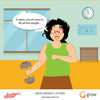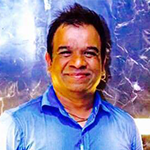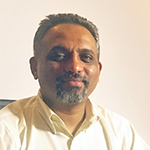How To Get A Handle On Hypertension Or High Blood Pressure
 Blood flowing inside vessels exerts a force against the walls - this is blood pressure.[/caption]
When we measure our blood pressure, its reading always has two numbers. The top number is systolic pressure, which is when the heart is contracting and diastolic pressure is when the heart is relaxing. The pressures are categorised as follows:
Blood flowing inside vessels exerts a force against the walls - this is blood pressure.[/caption]
When we measure our blood pressure, its reading always has two numbers. The top number is systolic pressure, which is when the heart is contracting and diastolic pressure is when the heart is relaxing. The pressures are categorised as follows:
- Normal: Less than 120 over 80 (120/80)
- Prehypertension: 120-139 over 80-89
- Stage 1 high blood pressure: 140-159 over 90-99
- Stage 2 high blood pressure: 160 and above over 100 and above
- High blood pressure in people over age 60: 150 and above over 90 and above
- Severe headaches
- Severe anxiety
- Shortness of breath
- Nosebleeds
- High intake of salt
- Excessive consumption of processed foods
- Obesity
- Lack of physical activity
- Smoking
- Stress
- Alcohol consumption
- Genetics or heredity
- Old age
- Thyroid disorders

- Chronic kidney disease: When blood vessels narrow in the kidneys, possibly causing kidney failure.
- Eye damage: When blood vessels in the eyes burst or bleed. Signs and symptoms include vision changes or even blindness.
- Cognitive changes: Research shows that over time, higher blood pressure numbers can lead to cognitive changes. Signs and symptoms include memory loss, difficulty finding words and losing focus during conversations.
- Aneurysms: When an abnormal bulge forms in the wall of an artery. Aneurysms develop and grow for years without causing signs or symptoms until they rupture, or grow large enough to press on nearby body parts or block blood flow. The signs and symptoms that develop depend on the location of the aneurysm.
- Heart attack: When the flow of oxygen-rich blood to a section of the heart muscle suddenly becomes blocked and the heart doesn’t get oxygen. The most common warning symptoms of a heart attack are chest pain or discomfort, upper body discomfort and shortness of breath.
- Peripheral artery disease: When plaque builds up in the leg arteries and affects blood flow in the legs. When people have symptoms, the most common are pain, cramping, numbness, aching or heaviness in the legs, feet and buttocks after walking or climbing stairs.
- Heart failure: When the heart can’t pump enough blood to meet the body’s needs. Common signs and symptoms of heart failure include shortness of breath or trouble breathing, feeling tired and swelling in the ankles, feet, legs, abdomen and veins in the neck.
- Stroke: When the flow of oxygen-rich blood to a portion of the brain is blocked. The symptoms of a stroke include a sudden onset of weakness, paralysis or numbness of the face, arms or legs, trouble speaking or understanding speech and trouble seeing.

- Losing weight if you are overweight or obese
- Quitting smoking
- Eating a healthy diet, including the DASH diet (eating more fruits, vegetables and low-fat dairy products, less saturated and total fats)
- Reducing the amount of sodium in your diet to less than 1,500 milligrams a day if you have high blood pressure; healthy adults should try to limit their sodium intake to no more 2,300 milligrams a day (about 1 teaspoon of salt).
- Getting regular aerobic exercise (such as brisk walking for at least 30 minutes a day, several days a week)
- Limiting alcohol to two drinks a day for men, one drink a day for women
 ressure is to start using the DASH diet. DASH stands for Dietary Approaches to Stop Hypertension. The diet is simple:
The DASH eating plan includes whole grains, poultry, fish and nuts and has low quantities of fat, red meat, sweets and sugared beverages. It is also high in potassium, calcium and magnesium, as well as protein and fibre. The plan cuts back on the amount of sodium that you get from food and drink. To start with the DASH diet, we have to limit sodium intake to 2,400 mg. (approx 1 tsp salt). Once you are well adjusted with 2,400 mg. sodium then you can cut back to 1,500 mg. Try to maintain 1,500 mg. in a diet which accounts for all sodium present in food products as well as in what you cook with or add at the table.
ressure is to start using the DASH diet. DASH stands for Dietary Approaches to Stop Hypertension. The diet is simple:
The DASH eating plan includes whole grains, poultry, fish and nuts and has low quantities of fat, red meat, sweets and sugared beverages. It is also high in potassium, calcium and magnesium, as well as protein and fibre. The plan cuts back on the amount of sodium that you get from food and drink. To start with the DASH diet, we have to limit sodium intake to 2,400 mg. (approx 1 tsp salt). Once you are well adjusted with 2,400 mg. sodium then you can cut back to 1,500 mg. Try to maintain 1,500 mg. in a diet which accounts for all sodium present in food products as well as in what you cook with or add at the table.
 Download the Grow Fit app on Google Play or App Store today for the DASH diet plan.
Download the Grow Fit app on Google Play or App Store today for the DASH diet plan.
- Tags: aneurysms calcium chronic kidney disease cognitive changes DASH diet diastolic pressure excessive consumption of processed foods eye damage fibre fish genetics or heredity heart attack high blood pressure high intake of salt hypertension lack of physical activity Lifestyle Disease magnesium nosebleeds nuts obesity old age peripheral artery disease potassium poultry prehypertension protein severe anxiety severe headaches shortness of breath smoking stress alcohol consumption stroke stroke or heart failure systolic pressure thyroid disorders whole grains
- 3







 I've started getting healthy meals from Grow at 7 p.m. everyday, along with nuts and smoothies that I'm very happy with. Now I feel better about my options for dinner thanks to Grow's Stay Fit Programme!
I've started getting healthy meals from Grow at 7 p.m. everyday, along with nuts and smoothies that I'm very happy with. Now I feel better about my options for dinner thanks to Grow's Stay Fit Programme!










Comments 0